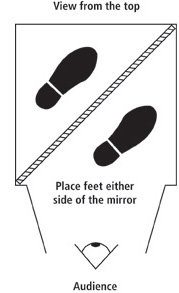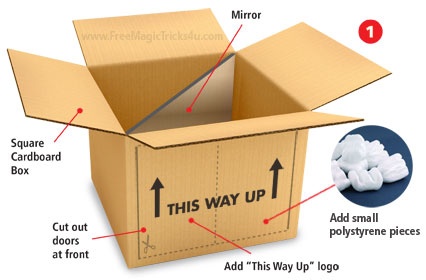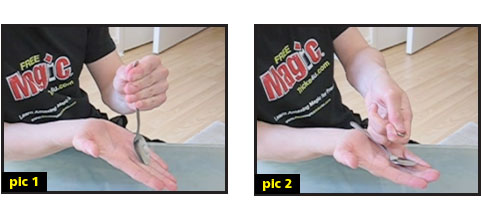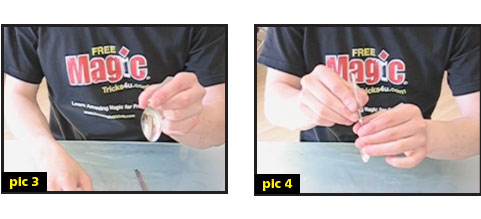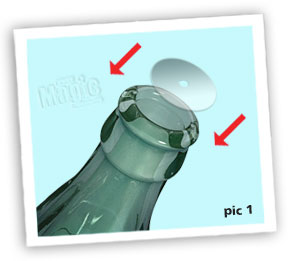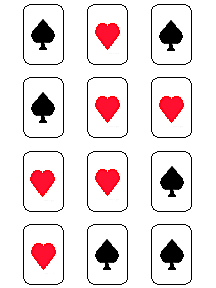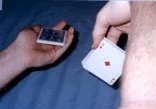This title will doubtless apply to many tricks with handkerchiefs, so, if the performer thinks it too general, he can find another of his own for this particular trick. Herrmann called it Le Mouchoir Serpent, from the fancied resemblance to a snake which the handkerchief was made to take at one stage of the trick. For it the performer must have prepared a lemon, with a small handkerchief inside. The way to operate on the lemon is as follows: Cut off one end—the apex is the best—and then, by means of a spoon, take out the whole of the interior, being careful to remove the inner white skin. Push in the handkerchief, replace the portion of lemon which you cut off, and sew it carefully on with yellow cotton or silk. The first lemon or two are rather tiresome to prepare, but after a time the job can be done very quickly and neatly. The method of sewing which should be adopted is that known as "under-sewing," and it will be necessary to guard against including the handkerchief itself in the stitching. As the handkerchief placed inside is meant to be subsequently destroyed, it need be of the very commonest description only. It can be obtained for three-halfpence. On the centre table have a small scent-bottle, with methylated spirits, a lighted candle, a common plate, and a knife. Concealed in the palm of one hand are about ten pieces of cambric, each about three inches square, and properly hemmed. Under the vest is a piece of cambric two inches broad and about four feet long, doubled, not rolled, up. Behind the scenes are a couple of pieces of thin wrapping paper about nine inches square. In the hand not occupied by the pieces conceal the prepared lemon, and advance to the audience. Pretend to see something in a gentleman's hair, and, after fumbling in it, produce the lemon. Let several persons smell at the fruit, taking care to present the better-looking end, in case your sewing has not been very successful. Of course, the lemon must not leave your hand, except to be tossed once or twice in the air, to show that it is real. Place this lemon on a side table, and there leave it, with the sewn-up end from the audience.
Now borrow a small handkerchief, the smaller the better but do not take one that is much ornamented with lace Turn to a gentleman, and, whilst asking him to stand up, roll the handkerchief up carelessly in the hand, and, working it round the bundle of pieces which you have concealed, bring it underneath and let the pieces appear at the top. This can be done in an instant whilst you are talking with the person whom you wish to assist you. Give the bundle of pieces, which the audience will think is the handkerchief, to him, with instructions to rub it gently in the hands. You have, in the meantime, taken care to keep the exchanged handkerchief well concealed in the palm. Retire to the stage, and, whilst mounting it, vest the handkerchief and take in its place the doubled-up long piece, which keep concealed by means of the wand. Ask your assistant how he is getting on, and explain that you wish him to rub the handkerchief so small that it can be passed inside the lemon. After a little rubbing has taken place, ask him to open the handkerchief out, to see if it is any smaller. Of course, when he attempts to do so, it will drop about in pieces, to everyone's astonishment. Affect great annoyance, and advance, saying that the trick is now spoilt all through the handkerchief being rubbed the wrong way. Collect the pieces together, and, rolling them up, exchange them in the hand for the long piece. This exchange may at first seem very daring and difficult, but, if care is taken always to have the piece or pieces concealed well down in the hand before the substituted article is removed, there need be no fear of detection; only the performer must go right at it, and not falter in the least. Give the long piece to your assistant, and tell him to rub it this time with the left hand. Whichever way he rubs you must say is the wrong one, and finally ask him to give you one of the pieces that you may show him what you mean. In his attempt to give you one of the supposed pieces, he will unroll the long piece amidst much laughter. After suggesting that the gentleman pays for the destroyed handkerchief, rub it up in the hands and "pass" it into the lemon. For this purpose, it may be rolled up on the table, and passed down a trap.
Instead of "passing" with the hands, it is in every way neater and more effective to use a conjuring pistol, which is loaded with the handkerchief and then fired. This pistol will have to be provided with a large tin funnel, so constructed that the tube portion, which must fit the barrel of the pistol closely, extends for a long way inside the funnel. When a handkerchief, or similar article, is rammed into the funnel, care is taken that it goes around the tube so that, on the pistol, which has been previously loaded, being fired, the flash passes harmlessly down the tube. The mouth of the funnel must never, by any chance, be seen by the audience. These pistols, which are exceedingly useful at all times, can be purchased at conjuring repositories; but it is easy for anyone possessing an ordinary pistol to have it fitted with a funnel by a tinman.
Suppose the long piece either "passed" or fired out of the pistol, take the lemon and cut it open with the knife, and pull out the handkerchief that was already in it. Pretend to advance for the purpose of returning it to its owner, but suddenly discover that it smells of lemon. Say that you will put some scent on it, and, placing it upon the plate, saturate it with spirits from your bottle. Whilst advancing a step or two, to inquire if it is enough, your stage attendant enters and quietly sets light to the spirits with the candle. You turn back and nearly burn your fingers, and start aside horror-stricken.
A slight scene now takes place between you and your attendant, who insists that you told him to set fire to the handkerchief. Run down to the audience with the plate and its blazing contents, asking the owner of the handkerchief to take it in its present state. Turn back and drop it on the floor of the stage, and then go behind the scenes, where quickly take the original borrowed handkerchief from the vest, and wrap it in one of the two pieces of paper (it will add to the effect if you scent the handkerchief a little), which hold in the hand covered by the second piece of paper, open. During your absence your attendant has been dancing about, affecting to burn his fingers, &c. When the handkerchief is nearly burnt out, snatch up the remains of it quickly and pop it into the open piece of paper, roll it up rapidly and exchange for the real handkerchief in paper, vesting it at once, or a severe burn may ensue. This is done whilst hurrying towards the owner of the handkerchief, to whom you say that you have done the best you can, and are sorry that you have only the ashes of the handkerchief to offer; but that if she will leave her address, you will forward a new one in the morning, &c. Finally, you have the supposed ashes blown upon, and then tear open the paper, revealing the handkerchief. If you have scented it, call attention to the fact.
If I wanted to test a conjuror's ability, I should give him this trick to perform. No duffer could ever get half way through it; and yet, by attention to the rudiments of palming, &c., it becomes easy enough. There can be no two opinions about the effect produced. The principal portions should be rehearsed with your attendant.
A very amusing variation to this trick is the following: Purchase two cheap sunshades of a precisely similar pattern. They should be small, and the covers of light alpaca. From one carefully strip the cover, so as to leave the ribs bare, and, at the end of each rib, fasten a piece of cambric exactly similar to those used in the rubbing-away episode. This sunshade have lying upon the shelf at the back of the table, rolled up in paper. In one of the large side pockets have concealed the cover, rolled up and tied with very fine thread, that may be easily broken. Upon the table have lying a piece of paper similar to that in which the sunshade upon the shelf is wrapped. At the opening of the trick, show this sunshade round, and then proceed to wrap it up in paper, on the table. You will always have some extra sheets, and behind one of these the one sunshade is exchanged for the other. Give it to be held in the company. Then borrow a hat, and secretly introduce the cover, placing the hat on a side table. When the trick has proceeded as far as the discovery of the small pieces in the hands of the spectator who is rubbing the handkerchief, place them in the pistol and fire at the sunshade held in the company. Great amusement ensues when the bare ribs are discovered, with the pieces of cambric flying from them. These are then taken off, and the trick proceeded with, as before described, the cover being discovered in the hat at any convenient period. Break the thread, and shake it out well before bringing to view, so as not to suggest any idea of its ever having been rolled up tightly into small bulk.
Credits to classicmagic.net for this trick







